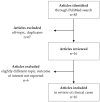Neonatal Thyrotoxicosis in Infants of Mothers with Graves' Disease Treated for Radioiodine-Induced Hypothyroidism: A Literature Review
- PMID: 39201903
- PMCID: PMC11352502
- DOI: 10.3390/children11080968
Neonatal Thyrotoxicosis in Infants of Mothers with Graves' Disease Treated for Radioiodine-Induced Hypothyroidism: A Literature Review
Abstract
Fetal and neonatal thyrotoxicosis occurs in up to 5% of pregnancies in mothers with Graves' disease (GD). This condition is caused by stimulating antibodies against the thyrotropin receptor (TRAbs) that cross the placenta and may stimulate the fetal thyroid, typically in the second half of pregnancy. GD is often treated with radioiodine, resulting in hypothyroidism in most patients, but TRAbs can persist for several years. Even if a pregnant mother is hypothyroid after radioiodine therapy or surgery, her TRAbs can still, although rarely, induce fetal hyperthyroidism. In this review, we first present two cases of neonatal hyperthyroidism in mothers with GD who became hypothyroid after prior radioiodine therapy, identified through a 10-year analysis of the National Perinatal System in Slovenia. Based on these cases, we provide an overview of existing data on this rare clinical condition in neonates. We also discuss the underlying mechanisms and clinical outcomes based on currently available data. In conclusion, our review highlights the importance of careful monitoring during pregnancy in all women with GD, even in those well managed after radioiodine therapy or surgery.
Keywords: Graves’ disease; fetal thyrotoxicosis; neonatal thyrotoxicosis; radioiodine treatment; stimulating antibodies against thyrotropin receptor.
Conflict of interest statement
The authors declare no conflicts of interest.
Figures
Similar articles
-
Thyroid-Stimulating Hormone Receptor Antibodies in Pregnancy: Clinical Relevance.Front Endocrinol (Lausanne). 2017 Jun 30;8:137. doi: 10.3389/fendo.2017.00137. eCollection 2017. Front Endocrinol (Lausanne). 2017. PMID: 28713331 Free PMC article. Review.
-
[Characterization of children born to mothers with Graves' disease].Andes Pediatr. 2021 Aug;92(4):556-564. doi: 10.32641/andespediatr.v92i4.3454. Andes Pediatr. 2021. PMID: 34652374 Spanish.
-
Transient Neonatal Hypothyroidism Followed by Hyperthyroidism Due to Maternal Thyrotropin Receptor Antibodies.JCEM Case Rep. 2025 Mar 7;3(3):luaf040. doi: 10.1210/jcemcr/luaf040. eCollection 2025 Mar. JCEM Case Rep. 2025. PMID: 40061242 Free PMC article.
-
Persistent high TRAb values during pregnancy predict increased risk of neonatal hyperthyroidism following radioiodine therapy for refractory hyperthyroidism.Endocr J. 2011;58(1):55-8. doi: 10.1507/endocrj.k10e-123. Epub 2010 Oct 15. Endocr J. 2011. PMID: 20962435
-
Foetal and neonatal thyroid disorders.Minerva Pediatr. 2002 Oct;54(5):383-400. Minerva Pediatr. 2002. PMID: 12244277 Review. English, Italian.
References
Publication types
LinkOut - more resources
Full Text Sources



